THE EFFECTS OF LIGHT EXPOSURE AND HEAT-AGING ON SELECTED QUILTING PRODUCTS CONTAINING ADHESIVES
Janet Evenson, & Patricia Cox Crews
3 RESULTS AND DISCUSSION
3.1 ADHESIVE SPRAYS
Results showed that one adhesive spray yellowed more than the others (table 1). Specimens containing Sullivans adhesive spray yellowed significantly more than the control or other adhesive sprays following both 40 and 80 AFUs of light exposure, as well as
Table .
Mean Color Difference Values for Adhesive Sprays Following Light Exposure and Heat-Aging
 |
Table .
Mean Percent Change in Breaking Strength for Adhesive Sprays Following Light Exposure and Heat-Aging
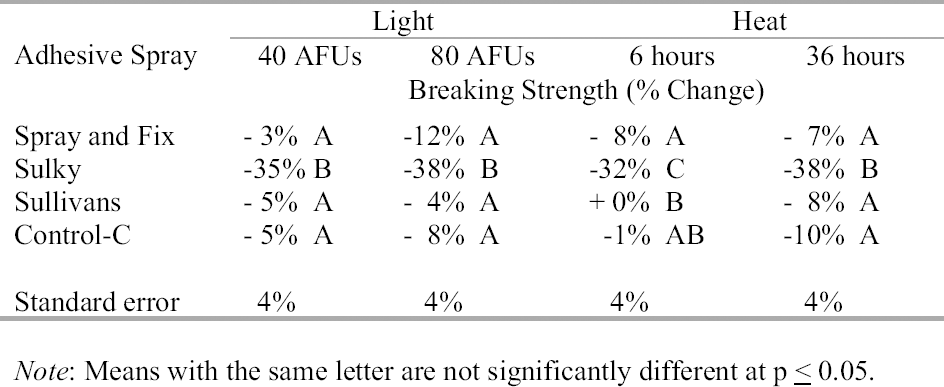 |
Table .
Mean Change in Flexural Rigidity for Adhesive Sprays Following Light Exposure and Heat-Aging
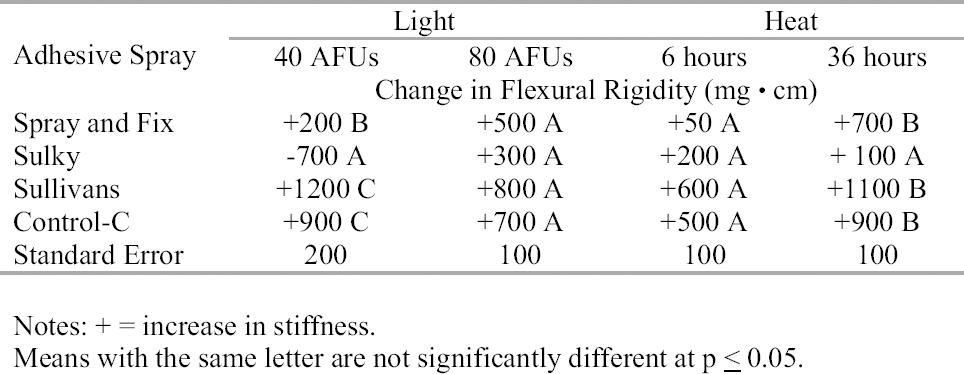 |
Table .
Mean Color Difference Values for Fusible Webs Following Light Exposure and Heat-Aging
 |
following 36 hours of heat aging. On the other hand, Sulky adhesive spray specimens exhibited significantly greater strength losses (>30% loss) compared to the control (~5% loss) or other adhesive spray specimens following 40 and 80 AFUs of light exposure, as well as following 6 and 36 hours of heat-aging (table 2). Despite significant discoloration associated with Sullivans spray adhesive, it exhibited no more strength loss than the control. Spray and Fix was the only adhesive spray product for which there was no significant difference from the control in terms of yellowing, strength loss, and stiffness.
All the adhesive spray specimens (except Sulky) stiffened following heataging and light exposure, but no more than the controls (table 3). Unexpectedly, Sulky spray adhesive specimens exhibited a significant loss of flexural rigidity following 40 AFUs of light exposure. This decrease in stiffness may be due to fiber degradation as reflected in the significant strength losses Sulky specimens exhibited following light exposure. As light exposure lengthened to 80 AFUs, photo-oxidation-induced changes resulted in a stiffening of Sulky specimens, as in all other specimens.
The significant differences observed between adhesive sprays were due to differences in product formulations. Spray and Fix, the PVAC-based adhesive formulation, performed satisfactorily. As previously mentioned, PVAC-based adhesive formulations have been used successfully by conservators for many years. Nevertheless, it must be noted that formulations of commercial products frequently change, and often without notice. Furthermore, the product formulation currently is not listed on commercial quilt-basting spray product labels. Therefore, quiltmakers who wish to use an adhesive spray in a quilt they intend to become an heirloom should carefully weigh the calculated risks against the convenience. The most prudent practice would be to avoid using commercial spray adhesives entirely because the adhesive formulation is not identified on product labels at this time. Collectors and curators may wish to avoid acquisition of quilts constructed using an adhesive spray.
3.2 FUSIBLE WEBS
In general, the fusible webs exhibited no more yellowing, stiffening, or strength losses than the control following 6 hours of heat-aging or 40 AFUs of light exposure (table 4). This result suggests that fusible webs may perform acceptably in quilts and household textiles intended for a life span of less than 100 years.
On the other hand, following 36 hours of heataging, all the fusible webs exhibited undesirable yellowing or product bleed-through. Wonder-Under exhibited significantly greater amounts of color change than the control following 80 AFUs of light exposure, but this color change was not yellowing. Instead, Wonder-Under exhibited significant product bleed-through, making the appearance unacceptable. In addition, Wonder-Under exhibited significantly greater stiffening than the control following 36 hours of heat-aging (table 5). HeatnBond–—the PVOH adhesive formulation—yellowed significantly more than the others. In addition, HeatnBond exhibited significantly greater strength losses after 36 hours of heat-aging than the control or any other fusible web (table 6).
These findings suggest that fusible webs should
Table .
Mean Change in Flexural Rigidity for Fusible Webs Following Light Exposure and Heat-Aging
 |
Table .
Mean Percent Change in Breaking Strength for Fusible Webs Following Light Exposure and Heat-Aging
 |
Table .
Mean Color Difference Values for Fusible Battings Following Light Exposure and Heat-Aging
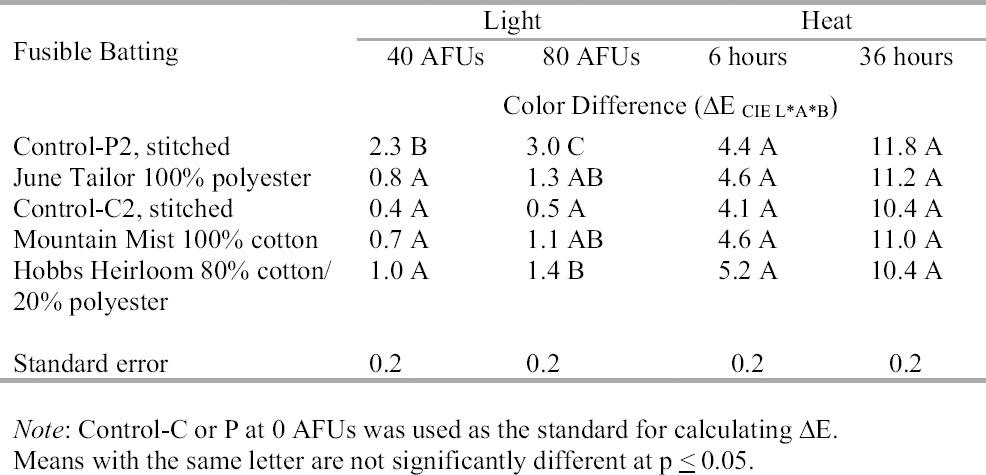 |
Table .
Mean Percent Change in Breaking Strength for Fusible Battings Following Light Exposure and Heat-Aging
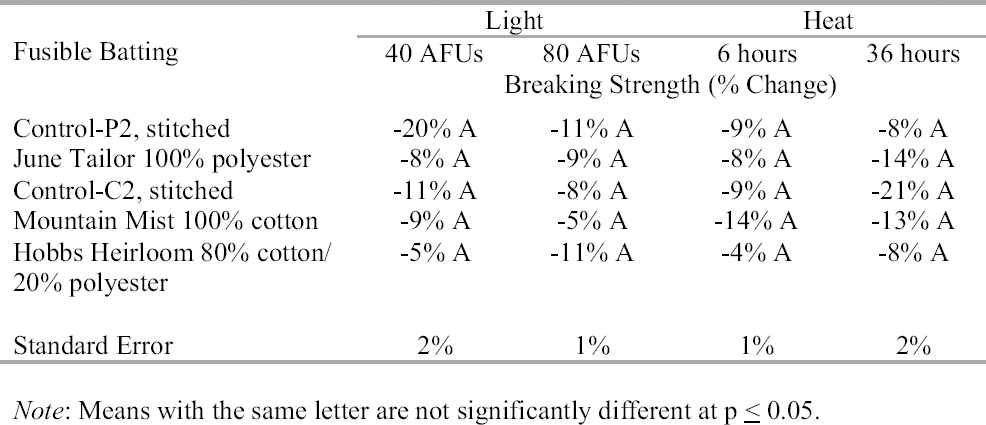 |
Table .
Mean Change in Flexural Rigidity for Fusible Battings Following Light Exposure and Heat-Aging
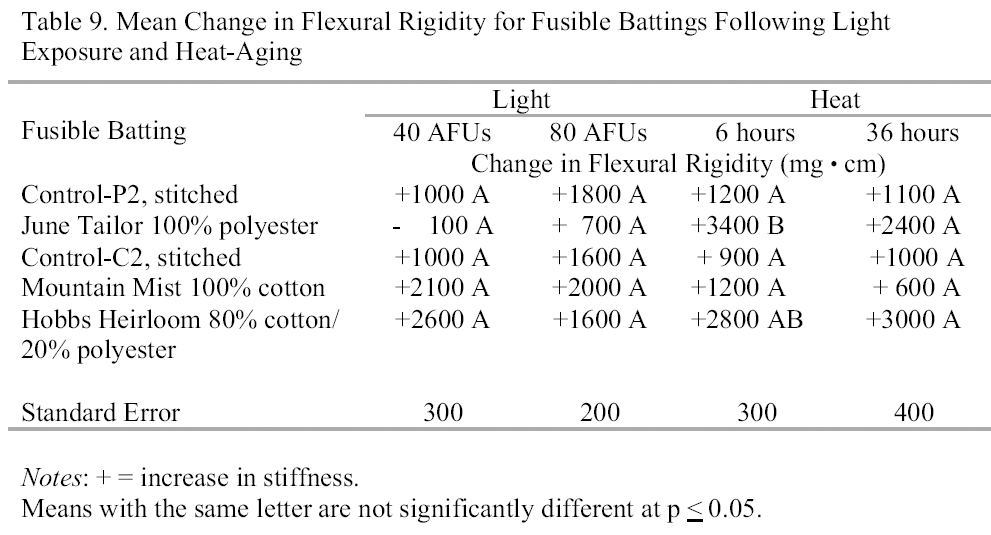 |
not be incorporated in quilts that makers hope will become heirlooms. Because the two polyamide products (Stitch Witchery and Wonder-Under) behaved very differently from each other, it is also clear that knowing the general chemical class of an adhesive as provided on a product label is insufficient information to make an informed decision.
3.3 FUSIBLE BATTINGS
All fusible batting products exhibited more yellowing following heat-aging than following light exposure (table 7). None, however, exhibited more yellowing than the controls. In terms of strength loss and stiffness, none of the fusible batting fabric assemblies were significantly different from controls following 80 AFUs of light or 36 hours of heat-aging (tables 8, 9). When incorporated into fabric assemblies, fusible battings exhibited less color change than fabric assemblies containing adhesive sprays or fusible webs. The adhesives used in the fusible battings proved to be the most resistant to heat and light of any of the products evaluated.
|